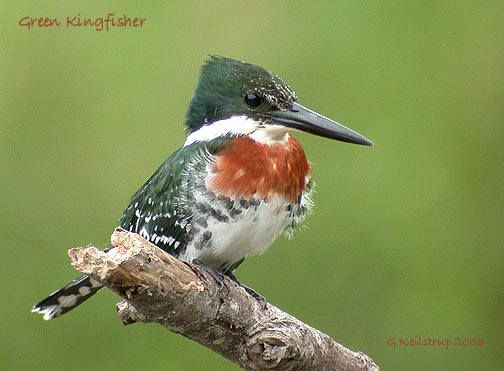- Chloroceryle americana
Identification
Green Kingfishers are small (approximately 19 to 20 cm [7.5 to 8 inches]), dark glossy green with white underparts, white collar, green spotting on breast and sides, and white markings on the wings and tail. Male has broad chestnut-colored breast band. Female has one or two green spotted breast bands. Typical kingfisher shape, with short tail and long, strong bill.
Distribution
Southern Texas to northern Argentina and northern Chile
The Green Kingfisher has a large range, estimated globally at 16,000,000 square kilometers. The bird is native to the Americas and prefers a forest, wetland or marine ecosystem, though it has been known to live in urban areas or in canals or ditches. The population is estimated globally at 5,000,000 to 50,000,000 individuals. The population does not show signs of decline that would necessitate inclusion on the IUCN Red List. Because of these population trends, the current evaluation level of the Green Kingfisher is Least Concern.
Taxonomy
Polytypic. Consists of five subspecies.
Habitat
Riparian woodlands; shade trees on the banks of rivers and resacas, preferring sheltered pools
Behaviour
Green Kingfishers like shaded, tree-lined pools and streams with clear water. Will sit for long periods of time on low perch scanning the water until they spot a small fish. Then it will make a quick, shallow dive into the water after its prey. Rarely hovers. They will also eat aquatic insects, and if they are not near water, they will feed on grasshoppers or small lizards. As with most kingfishers, you may hear their rattling call before you see them. The nest is a deep 2 to 3 foot tunnel high on a sandy bank near water. There is a small entrance, 2 to 3 inches wide, probably covered with plants, vines, or other vegetation draping over the entrance. Female lays three, sometimes four, eggs.




